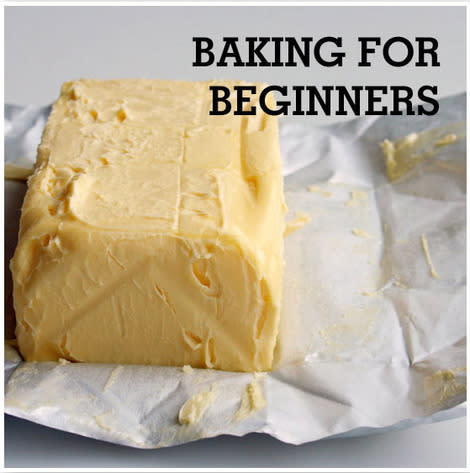Baking Basics: 10 Tips for Beginner Bakers

Source: Baking Basics: 10 Tips For Beginner Bakers
Every baker must begin somewhere, yet the calculated science behind baking is not always simple and intuitive for some, especially cooks who prefer to improvise in the kitchen instead of following a recipe verbatim. If you're new to baking or have had rough (aka messy or burnt) experience in the past, here are 10 tips every beginner baker should know going into a recipe.
Read the Recipe in Its Entirety: Read the entire recipe slowly that way ingredients, tools, and steps aren't accidentally overlooked. Baking is about precision, so it's very important that you are familiar with the recipe before beginning. Read it two or three times even to make sure everything sounds clear.
Pull Out All the Ingredients and Tools Needed: Prior to beginning the recipe, pull out all of the ingredients and tools that the recipe calls for. Then double-check that you have everything. There's nothing worse than realizing you are missing a crucial ingredient or tool halfway through making the recipe.
Bring the Ingredients to Room Temperature: Oftentimes, butter and eggs need to come to room temperature for a recipe. Pull out those ingredients, and store them on the counter several hours prior to making the recipe.
Properly Prepare Cookie Sheets or Cake Pans : If the recipe calls for the cake pan to be greased or for the cookie sheet to be topped with parchment paper, then follow the direction. It will save you from burnt, sticky, or broken confections plus cleanup will be a breeze. You don't want to waste hours of scrubbing hardened crumbs off of your bakeware.
Preheat the Oven: Most recipes will remind you to preheat the oven at the start of the recipe; get in the habit of preheating the oven before you put anything in it.
More from YumSugar: 10 Tricks For Better Fruit Salads
Use Liquid and Dry Measuring Cups: Unless a recipe indicates that you should only use one type of measuring cup, assume that liquids (milk or water) should be measured out with a liquid measuring cup, and dry ingredients (sugar, flour, nuts, and chocolate chips) should be measured out using nested dry measuring cups.
Sift Dry Ingredients : It can be a pain, but sifting the dry ingredients improves the overall texture of the baked good plus gets rid of any lumps and clumps. Sift the ingredients into a large bowl or wax paper to avoid a mess.
Crack Eggs in a Separate Bowl: It's a bad idea to crack eggs directly into the batter bowl, because there's a greater risk of tainting it with egg shell shards or a rotten egg. Instead, crack each egg individually into a separate bowl, check for any shell, and make sure the yolk isn't broken before pouring the raw egg into the batter bowl. Remove shards by taking the empty egg shell half and using it to scoop the shell bits out of the gelatinous egg.
Combine Ingredients According to the Recipe : I've seen it more than once - some newbies to baking will dump all of the ingredients together, in the same bowl at the same time. It sounds obvious, but consult the recipe, then slowly and carefully add each ingredient into the bowl.
Set a Timer: The first thing you should do after inserting the pan into the oven is set a timer. It's easy to forget when you keep track of the time in your head. You are better off setting a device with a loud, obnoxious alarm so you don't run the risk of burning your precious, hard-earned work.
Related Content:
How to Make Pie Crust, in Pictures
A Simple and Tasty Yogurt Quick Bread
Weighty Matters: Common Weight Equivalents of Ingredients
Follow YumSugar on Twitter
Become a Fan of YumSugar on Facebook
